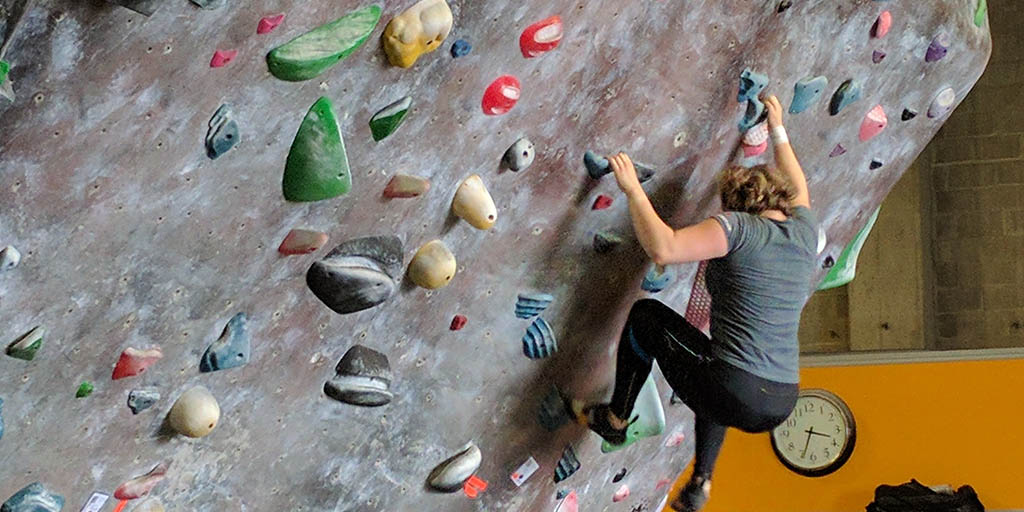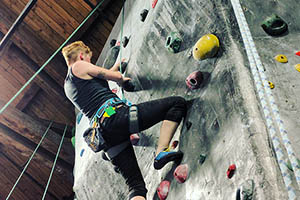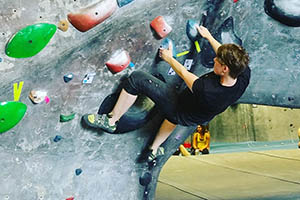An introduction to rock climbing
 CREDIT: ALL PHOTOS COURTESY OF CARLIE FORSYTHE
CREDIT: ALL PHOTOS COURTESY OF CARLIE FORSYTHERock climbing is a challenging, but fun activity to try out and master. With the help of some information and a lot of practice, you'll soon be on your way to conquering a variety of rock walls.
If you're anything like me and love adventure and learning new skills, then perhaps rock climbing is the sport for you. Luckily for you, you can try your hand at rock climbing at our new Student Wellness and Fitness Centre or at London's The Junction Climbing Centre. You may be curious about the sport, or just completely terrified of heights, but as a fellow rock climbing enthusiast, I'm here to give you some information and guidance about rock climbing.
First, let's discuss the sport and all of its variations. First, there's two types of climbing: routes and boulders.
Routes
Route climbing is where there are various holds drilled into a vertical wall that the climber uses to ascend to the top either by way of a belayer or an auto belay device. A belayer is a climbing partner who uses a climbing rope and a belay device (used for climber's safety), such as the Petzl Gri Gri, to ensure the climber will not fall far, and will also lower the climber once the route has been completed. An auto belay device does much of the same job as a belayer and allows a climber to climb their routes solo.
Within route climbing, there are two main disciplines: top rope and lead. Top rope requires a climbing rope to be installed at the top of the route that hangs down for the climber and belayer to use. The climber will tie themselves in and the belayer will attach themselves to the rope using a belay device. Top rope belaying is very simple to learn for any climber who has attempted the sport and any climbing gym will offer lessons.
Benefits to top rope climbing are:
� The climber may take rests while climbing without being immediately lowered, which gives them an opportunity to figure out the route's “beta”, or the preferred set of movements and holds to complete the route.
� Top rope climbing is easily accessible in any climbing gym, and allows climbers many different routes to attempt.
� Top rope climbing allows the climber to become a stronger, more technical climber who can conquer tougher routes and is usually the precursor to lead.
Lead climbing is a little different and requires additional expertise. Lead climbing is broken out into two different disciplines: sport and trad. Sport lead climbing can be found both in climbing gyms and outdoors and involves a climber who attaches a climbing rope to their harness who then clips the rope into “quick draws”, which are carabiners bolted to a wall every few feet on a route. These quick draws are how lead climbers protect themselves from falls. In order to belay for a lead climber, a climber should enroll themselves in a class at a climbing gym to learn correct lead belay techniques. Trad climbing is quite different. Trad climbers will use different gear, such as cams and stoppers which can be placed and removed from rock, to set their own route as they're climbing. The main principle of trad climbing is to leave no trace of your existence
Boulders
Bouldering is an entirely different sport altogether. Indoors, boulder walls are much shorter with fewer holds, the climber doesn't wear any gear except for shoes and a chalk bag and there's usually a nice soft mat on the floor to soften falls. The routes on boulder walls are called problems and may require several attempts before one masters a “problem”. Outdoors, climbers tackle actual boulders and usually bring along with them another climber to help spot and several bouldering pads to pad their falls from sharp rocky surfaces.
Grading
Every route and boulder problem is given a grade. Most rock climbing gyms in Ontario use the Yosemite Decimal System (YDS) for routes, which range from 5.4 (easiest) all the way to 5.15d (most difficult).
In bouldering, grading is quite different and is called the V Scale. Indoors, most boulder problems are on a scale of V0 (easiest) to V10 (most difficult), but the scale currently extends to V17.
What's in a grade? According to Wikipedia, there are a number of factors that help determine the difficulty or grade of a climb, they are: the technical difficulty of the moves required, the strength and stamina required to complete the climb, and the difficulty of protecting the climber.
Getting Started
You're excited to start climbing, what comes next? I'd recommend that you get a friend or two and head to your nearest climbing gym to try out a few of their auto belay routes and boulder wall. You'll need to rent a harness and I recommend renting a pair of climbing shoes, as well.
Once you've established that this is a sport you're interested in, you should take a top rope belay lesson to learn how to tie knots and belay properly. One session in a rental belay harness will have you wishing you had your own. A harness is the first piece of gear I recommend purchasing and you can do so at any outdoors specialty store, such as Mountain Equipment Co-op (MEC), or at your local climbing gym. Eventually, you may want to purchase your own shoes, but I recommend that you hold off (or purchase a cheap pair) until you've mastered your footwork on the wall.
Eventually, you may wish to take a lead course or try climbing outdoors for an entirely different experience. Happy climbing! Click on the thumbnails below to view a larger version of each image.
















